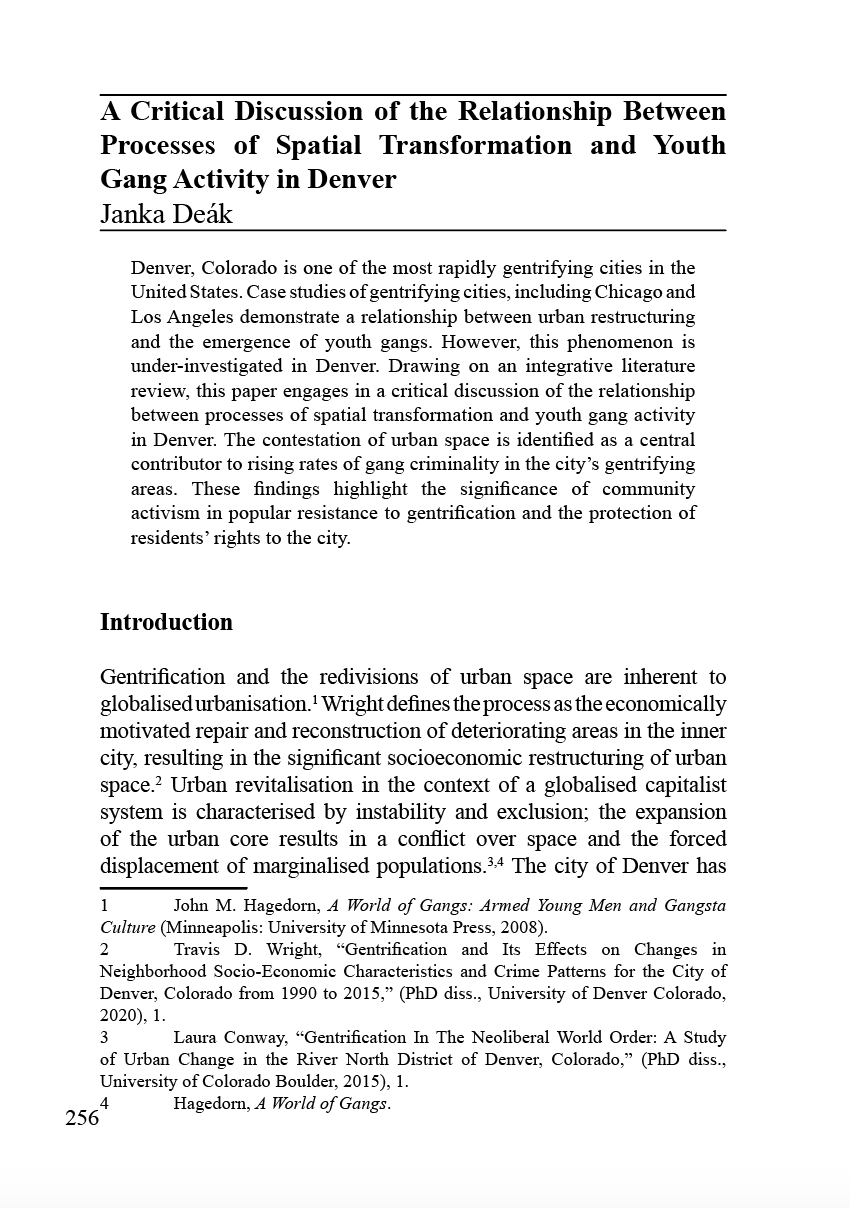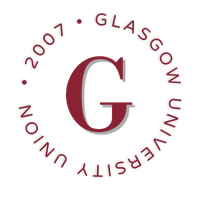A Critical Discussion of the Relationship Between Processes of Spatial Transformation and Youth Gang Activity in Denver
DOI:
https://doi.org/10.36399/GroundingsUG.15.127Keywords:
Gentrification, Urban Studies, Gangs, Gang Studies, Denver, Colorado, Residents' Rights, ActivismAbstract
Denver, Colorado is one of the most rapidly gentrifying cities in the United States. Case studies of gentrifying cities, including Chicago and Los Angeles demonstrate a relationship between urban restructuring and the emergence of youth gangs. However, this phenomenon is under-investigated in Denver. Drawing on an integrative literature review, this paper engages in a critical discussion of the relationship between processes of spatial transformation and youth gang activity in Denver. The contestation of urban space is identified as a central contributor to rising rates of gang criminality in the city’s gentrifying areas. These findings highlight the significance of community activism in popular resistance to gentrification and the protection of residents’ rights to the city.
References
Conway, Laura. “Gentrification In The Neoliberal World Order: A Study of Urban Change in the River North District of Denver, Colorado.” PhD diss., University of Colorado Boulder, 2015. Available at: https://scholar.colorado.edu/concern/parent/3n203z80v/file_sets/4f16c3616 (Accessed 15 Dec. 2022).
Durán, Robert J. “Racism, Resistance, and Repression: The Creation of Denver Gangs, 1924-1950,” In Enduring Legacies: Ethnic Histories and Cultures of Colorado, edited by Arturo J. Aldama, Elisa Facio, Daryl Maeda, and Reiland Rabaka, 113-126. Boulder: University Press of Colorado, 2010. (Accessed 15 December 2022).
Esbensen, Finn-Aage, David Huizinga, and Anne W. Weiher. “Gang and Non-Gang Youth: Differences in Explanatory Factors.” Journal of Contemporary Criminal Justice, 9, no. 2 (May 1993): 94-116. Available at: https://doi.org/10.1177/104398629300900203. (Accessed 15 Dec. 2022).
Esbensen, Finn-Aage and David Huizinga. “Gangs, drugs, and delinquency in a survey of urban youth.” Criminology, 31 no. 4 (November 1993): 565–589. Available at: https://doi.org/10.1111/j.1745-9125.1993.tb01142.x (Accessed 15 Dec. 2022).
Fraser, Alistair. Urban Legends: Gang Identity in the Post-Industrial City. Oxford: Oxford University Press, 2015.
Hagedorn, John M. “Gangs, Institutions, Race and Space: The Chicago School Revisited.” In Gangs in the Global City: Alternatives to Traditional Criminology, edited by John M. Hagedorn, 12-34. Urbana: University of Illinois Press, 2007.
Hagedorn, John M. “Gangs in Late Modernity,” In Gangs in the Global City: Alternatives to Traditional Criminology, edited by John M. Hagedorn, 12-34. Urbana: University of Illinois Press, 2007.
Hagedorn, John M., A World of Gangs: Armed Young Men and Gangsta Culture. Minneapolis: University of Minnesota Press, 2008.
Huizinga, David, Anne Wylie Weiher, Scott Menard Rachele Espiritu and Finn-Aage Esbensen, “Some Not So Boring Findings From The Denver Youth Survey.” Boulder: Institute of Behavioral Science, University of Colorado, 1998. Available at: https://www.ojp.gov/ncjrs/virtual-library/abstracts/some-not-so-boring-findings-denver-youth-survey (Accessed 28 Dec. 2022).
Krohn, Marvin D. and Terence P. Thornberry, “Longitudinal Perspectives on Adolescent Street Gangs.” In The Long View of Crime: A Synthesis of Longitudinal Research, edited by Akiva M. Liberman, 128-160. New York: Springer, 2008. Available at: https://doi.org/10.1007/978-0-387-71165-2_4 (Accessed 15 Dec. 2022).
Langegger, Sig. “Viva la Raza! A Park, a Riot and Neighbourhood Change in North Denver.” Urban Studies 50, no. 16 (April 2013): 3360–3377. Available at: https://doi.org/10.1177/0042098013483603 (Accessed 15 Dec. 2022).
Langegger, Sig. “Emergent public space: Sustaining Chicano culture in North Denver.” Cities 35 (December 2013): 26-32. Available at: https://doi.org/10.1016/j.cities.2013.04.013 (Accessed 15 Dec. 2022).
Langegger, Sig. “Right-of-way gentrification: Conflict, commodification and cosmopolitanism.” Urban Studies, 53, no. 9 (May 2016): 1803–1821. Available at: https://doi.org/10.1177/0042098015583783 (Accessed 15 Dec. 2022).
Page, Brian and Eric Ross. “Legacies of a Contested Campus: Urban Renewal, Community Resistance, and the Origins of Gentrification in Denver.” Urban Geography 38, no. 9 (September 2017): 1293-1328. Available at: https://doi.org/10.1080/02723638.2016.1228420 (Accessed 15 Dec. 2022).
Palmisano, Lucas W. “Post-industrial approaches to urban development in Denver, Colorado: evaluating strategic neighborhood plans.” PhD diss., University of Colorado Denver, 2014. Available at: https://digital.auraria.edu/work/ns/5f5856ce-68a9-47c7-b60c-8cac6e16c900 (Accessed 15 Dec. 2022).
Ridge, Zackary. “Unsettling Class: Gentrification and Racial Capitalism in Denver.” PhD diss., University of Colorado Boulder, 2020. Available at: https://www.proquest.com/openview/5af7c49c6a5bdd960df330075822bf02/1?pq-origsite=gscholar&cbl=18750&diss=y (Accessed 15 Dec. 2022).
Schmelzer, Elise. “Killings among Denver’s teens continue, even as city and community leaders try new solutions.” The Denver Post, February 16, 2020, https://www.denverpost.com/2020/02/16/denver-aurora-youth-gun-violence-2019/
Schmelzer, Elise. “Denver homicides fell slightly in 2022, but non-fatal shootings rose — and more teens are being killed.” The Denver Post, January 29, 2023, https://www.denverpost.com/2023/01/29/denver-homicides-shootings-2022/
Spergel, Irving A. The Youth Gang Problem. New York: Oxford University Press, 1995.
Thrasher, Frederic M. The Gang: A Study of 1,313 Gangs in Chicago. 3rd ed. Chicago: University of Chicago Press, 1963.
Vigil, James Diego, and Steve C. Yun. “A Cross-Cultural Framework for Understanding Gangs: Multiple Marginality and Los Angeles.” In Gangs in America (3rd ed), edited by C. Ronald Huff, 161-175. Thousand Oaks: Sage Publications, 2002.
Wacquant, Loïc J. D. “Three Pernicious Premises in the Study of the American Ghetto.” In Gangs in the Global City: Alternatives to Traditional Criminology, edited by John M. Hagedorn, 34-54. Urbana: University of Illinois Press, 2007.
Wacquant, Loïc J. D. Urban Outcasts: A Comparative Sociology of Advanced Marginality. Cambridge: Polity Press, 2013.
Wimbley, Lacretia and Allison Sherry. “A wave of gun violence in Denver and Aurora troubles community members and law enforcement.” CPR News, November 3, 2022. https://www.cpr.org/2022/11/03/denver-aurora-gun-violence/
Wright, Travis D. “Gentrification and Its Effects on Changes in Neighborhood Socio-Economic Characteristics and Crime Patterns for the City of Denver, Colorado from 1990 to 2015.” PhD diss., University of Denver Colorado, 2020. Available at: https://www.proquest.com/openview/9e440bf2606b57b72ebc7790fbd2e6db/1?pq-origsite=gscholar&cbl=18750&diss=y (Accessed 15 Dec. 2022).
Young, Jock. “Globalisation and Social Exclusion: The Sociology of Vindictiveness and the Criminology of Transgression.” In Gangs in the Global City: Alternatives to Traditional Criminology, edited by John M. Hagedorn, 54-95. Urbana: University of Illinois Press, 2007.

Downloads
Published
Issue
Section
License
Copyright (c) 2024 Janka Deák

This work is licensed under a Creative Commons Attribution 4.0 International License.
The CC BY 4.0 license is a Creative Commons license. This is a non-copyleft free license that is good for art and entertainment works, and educational works. It is compatible with all versions of the GNU GPL; however, like all CC licenses, it should not be used on software. People are free to: Share — copy and redistribute the material in any medium or format; Adapt — remix, transform, and build upon the material for any purpose, even commercially. The licensor cannot revoke these freedoms as long as you follow the license terms. But they must conform to the following terms: Attribution — You must give appropriate credit, provide a link to the license, and indicate if changes were made. You may do so in any reasonable manner, but not in any way that suggests the licensor endorses you or your use. No additional restrictions — You may not apply legal terms or technological measures that legally restrict others from doing anything the license permits.
Please check individual article PDF copies to see if any additional restrictions apply.







